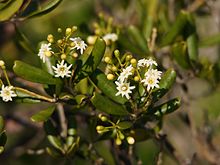
Ficus benjamina, commonly known as weeping fig, benjamin fig or ficus tree, and often sold in stores as just ficus, is a species of flowering plant in the family Moraceae, native to Asia and Australia. It is the official tree of Bangkok. The species is also naturalized in the West Indies and in the states of Florida and Arizona in the United States. In its native range, its small fruit are favored by some birds.
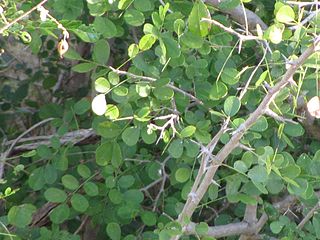
Dalbergia melanoxylon is a flowering plant in the family Fabaceae, native to seasonally dry regions of Africa from Senegal east to Eritrea and south to the north-eastern parts of South Africa. The tree is an important timber species in its native areas; it is used in the manufacture of musical instruments and fine furniture. Populations and genomic resources for genetic biodiversity maintenance in parts of its native range are threatened by overharvesting due to poor or absent conservation planning and by the species' low germination rates.

The Key West Tropical Forest & Botanical Garden is a frost-free arboretum and botanical garden containing a collection of trees, shrubs, and palms, including several "champion tree" specimens. It is located on Stock Island in the municipality of Key West, Florida, United States. It is open daily. There is a nominal fee for admission, with free admission for locals on the first Sunday of every month.

Ficus tinctoria, also known as dye fig, or humped fig is a hemiepiphytic tree of genus Ficus. It is also one of the species known as strangler fig.

From its peculiar habit, Duabanga grandiflora is a singular feature in its native forests. The trunk is erect, 40–80 feet high, undivided but sometimes forking from the base. The lower limbs spread drooping from the trunk; these are long, slender, sparingly branched, and the branches are four-angled, loosely covered with large spreading leaves. Since the leaves are arranged in two ranks, the slender branches resemble petioles, bearing pinnae of a compound leaf; the leaves are further often recurved, and are deep green above, and almost white beneath. The large blossoms expand in April, exhaling a rank odour reportedly resembling asafoetida when they first burst, but they become inodorous before the petals drop. The stamens are all bent inwards in bud. The fruit is a large as a small apple. The wood is white and soft.

The Vanikoro flying fox, also known locally as the basapine, is a species of bat in the family Pteropodidae. It has only been found in the Vanikoro island group located in the southern Solomon Islands. The species as a whole was originally known from just a few specimens collected sometime before 1930 but following surveys conducted on the island in the early 1990s did not detect this species again causing the Vanikoro flying fox to be listed as extinct. However, the species was rediscovered by a survey conducted in late 2014 which indicated a population in the high hundreds or low thousands and reported all observations.
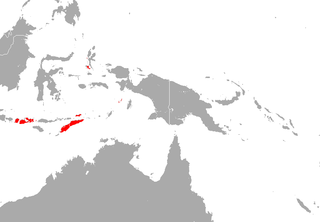
The insular horseshoe bat is a species of bat in the family Rhinolophidae. It is endemic to Indonesia.
Alseodaphne rugosa is a species of plant in the family Lauraceae. It is native to China and north Vietnam. It grows in mixed forests in valleys. It is threatened by habitat loss.
Vallea ecuadorensis is a species of tree in the Elaeocarpaceae family. Although formerly considered endemic to Ecuador it has also been collected in Bolivia and Peru. This species occurs in subtropical or tropical moist montane forests, at 2500 – 3500 meters above sea level.

Plumeria obtusa, the Singapore graveyard flower, is a species of the genus Plumeria (Apocynaceae). It is native to the West Indies, southern Mexico, Belize, Guatemala, and Florida. but widely cultivated for its ornamental and fragrant flowers around the world, where suitably warm climate exists. It is reportedly naturalized in China.

Cyclura cychlura figginsi, known by the common name of guana and sometimes called the Exuma Island iguana in the international literature, is a subspecies of the northern rock iguana, C. cychlura, that is found on the Exuma island chain in the Bahamas with an estimated wild population of 1,300 animals in 2004, it has been listed on the IUCN Red List as critically endangered.

Hypericum canariense is a species of flowering plant in the family Hypericaceae known by the common name Canary Islands St. John's wort. It is the sole member of Hypericumsect. Webbia.

The Kei flying fox is a species of megabat in the genus Pteropus found in the Kai Islands of Indonesia. It was formerly considered a subspecies of the black-bearded flying fox. Very little is known about the species, its habitat, or threats to it.

Populus heterophylla, also known as downy poplar, swamp poplar and swamp cottonwood, is a large deciduous poplar belonging to the Populus genus of the family Salicaceae. This species can grow on sites that have too much water for other native poplars. On the IUCN Red List this species is listed as "least concern".

Flacourtia indica, known commonly as ramontchi, governor's plum, Madagascar plum and Indian plum, is a species of flowering plant native to much of Africa and tropical and temperate parts of Asia. F. indica and F. ramontchi are sometimes treated as separate species.
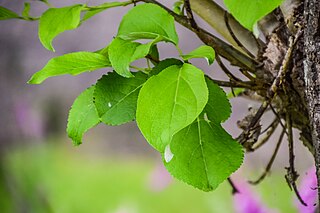
Populus suaveolens, called the Mongolian poplar, Korean poplar and Japanese poplar, is a species of flowering plant in the genus Populus, native to all of northern Asia, the Korean peninsula, the Kurils, and northern Japan. It is a tree reaching 30 m.
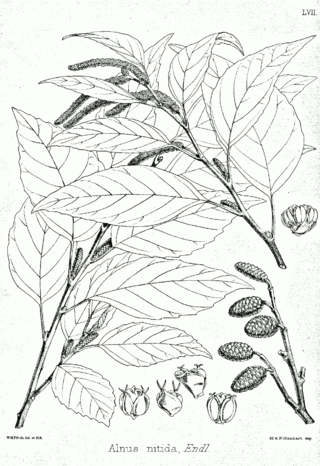
Alnus nitida, the west Himalayan alder, is a species in the genus Alnus, native to Pakistan, the western Himalayas, and Nepal. It is a tree reaching 20 to 25 m, preferring to live along the banks of rivers. It is used locally for timber and firewood, and as a street tree. The bark is used in some places for tanning and dyeing purposes. It grows well in heavy, clay soils and tolerates infertile soils. The leaves are thin, oval to ovate, 3-6 inches long and 2-3 inches wide. Female flowers appear first, followed by male catkinss in September to October, which may be up to 19 cm long. The fruits are woody cones, typically 2.5-3.5 cm long.
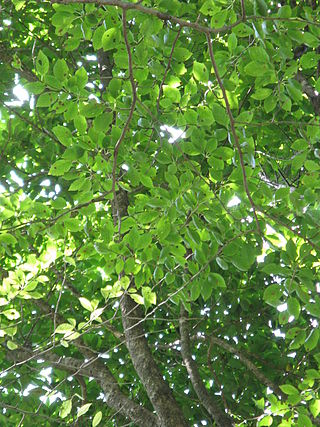
Ilex macropoda is a species of flowering plant in the holly family Aquifoliaceae, native to southern China, Korea, and Japan. A deciduous tree typically 13 m (43 ft) tall, it is found in mixed forests, forest edges, thickets, and roadsides, usually from 500 to 1,900 m above sea level. Local people make a tea by boiling its leaves.

Thevetia ahouai is a species of flowering plant in the family Apocynaceae, native to Mexico, Central America, Cuba, Colombia, and Venezuela, and introduced to southeastern China. An evergreen shrub or small tree of forests reaching 3 m (10 ft), it is used as a street tree in Nicaragua and Colombia.
